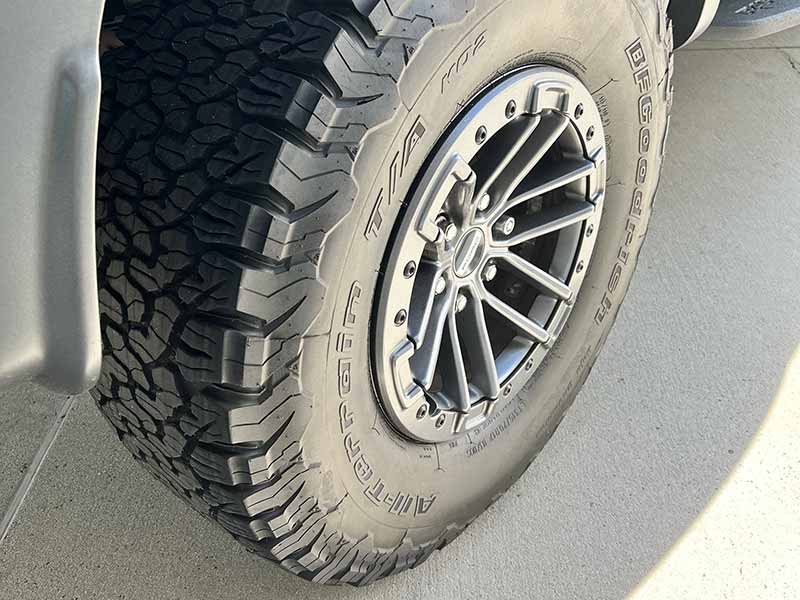It can be a little confusing trying to understand tire size and the importance and effects of a lower load carrying capacity versus higher capacity tires.
In simple terms, the tire load index tells you how much weight each tire can carry.
Properly inflated tires that meet the original equipment specifications means your tires can handle the maximum load carrying capacity of your car or truck.
What Does Tire Load Index Mean?
A tire’s load index number is a number that corresponds to the load carrying capacity that a vehicle’s individual tires can support safely at maximum air pressure.
Load index numbers range from 0 to 150 and correspond to 99 pounds to 7385 pounds of load carrying capacity per tire.
Ensuring your tires have the proper load index rating is important to ensure you can safely drive your car or truck without worry of a blowout due to sidewall failure.
Let’s take a closer look.
Where To Find Load Index On A Tire
The load index of a tire is molded into the sidewall of the tire as part of the tire size. It is the last numerical code included in the tire size. It is preceded by the wheel diameter and followed by the speed rating.
Load range, which is meant to be a simpler version of load index, is being added to some tires now. You can find this after the speed rating as a one or two letter designation.
Tire Load Index Chart
The full chart ranges from 0 to 150 but we will abbreviate it to 70 through 126 since the more extreme numbers are much less common. You can view the full chart at Discount Tire.
| Load Index | Carrying Capacity (pounds) |
|---|---|
| 70 | 739 |
| 71 | 761 |
| 72 | 783 |
| 73 | 805 |
| 74 | 827 |
| 75 | 853 |
| 76 | 882 |
| 77 | 908 |
| 78 | 937 |
| 79 | 963 |
| 80 | 992 |
| 81 | 1,019 |
| 82 | 1,047 |
| 83 | 1,074 |
| 84 | 1,102 |
| 85 | 1,135 |
| 86 | 1,168 |
| 87 | 1,201 |
| 88 | 1,235 |
| 89 | 1,279 |
| 90 | 1,323 |
| 91 | 1,356 |
| 92 | 1,389 |
| 93 | 1,433 |
| 94 | 1,477 |
| 95 | 1,521 |
| 96 | 1,565 |
| 97 | 1,609 |
| 98 | 1,653 |
| Load Index | Carrying Capacity (pounds) |
|---|---|
| 99 | 1,709 |
| 100 | 1,764 |
| 101 | 1,819 |
| 102 | 1,874 |
| 103 | 1,929 |
| 104 | 1,984 |
| 105 | 2,039 |
| 106 | 2,094 |
| 107 | 2,149 |
| 108 | 2,205 |
| 109 | 2,271 |
| 110 | 2,337 |
| 111 | 2,403 |
| 112 | 2,469 |
| 113 | 2,535 |
| 114 | 2,601 |
| 115 | 2,679 |
| 116 | 2,756 |
| 117 | 2,833 |
| 118 | 2,910 |
| 119 | 2,998 |
| 120 | 3,086 |
| 121 | 3,197 |
| 122 | 3,307 |
| 123 | 3,417 |
| 124 | 3,527 |
| 125 | 3,638 |
| 126 | 3,748 |
What Load Rating Tire Do I Need?
The easiest way to determine the required load rating you need for your tires is to match your new tires to the load rating on your OEM tires.
If you don’t have the original equipment tires still installed you can refer to your owner’s manual for this requirement.
If you’re hauling heavy loads you will need to calculate the load capacity needed based on your needs.
OEM tires are chosen to be able to support the weight of your vehicle, all of the potential passengers, and a sizable load in the storage areas such as a trunk.
If your vehicle is capable of towing heavier loads, it is likely also equipped with tires that can handle some extra towing load but you should take a moment to calculate the amount of extra load and ensure your tires are up to the challenge.
Is Tire Load Index Important?
It should be obvious that the load index of your tires is one of the more important specifications. The truth is that many people don’t even realize it’s something they should be concerned with.
This is because the tires on your car or truck are usually more than capable of supporting your car or truck plus a common amount of excess weight and an additional margin of safety on top of that.
Load index isn’t very important to most passenger car owners, but it should be given more attention. For instance, with the rise of electric cars with large and heavy battery packs, the need for higher load rated tires has become necessary.
Light truck owners that haul heavier loads or tow trailers with heavy loads often pay more attention to the load carrying capacity of their tires, but not all light truck owners give it the attention it deserves.
Trailer tires probably get the most attention since their main purpose is hauling heavy items.
How To Determine Tire Load Index
To roughly calculate the tire load index needed for your car or truck you can divide the gross vehicle weight rating (GVWR) by four. You can find the gross vehicle weight on a sticker in the driver’s door jam or owner’s manual.
This is not meant for trailer tires or for determining the tires you need for towing a trailer. This is simply the method for determining the maximum load your tires will need to support at each corner.
For a more accurate number you should always refer to your owner’s manual.
Does Load Index Affect Ride Quality?
Small differences in load index will likely not have any noticeable affect on ride quality. Large differences between load index ratings can have a noticeable difference in ride comfort, but the load index shouldn’t be your main factor for determining how comfortable a tire will ride.
Can I Buy Tires With A Different Load Index?
It’s not recommended to lower the index rating when you install new tires. The original equipment specifications should always be met or exceeded.
You can safely four tires with load indexes greater than the OEM specification. But you should never install tires with a lower carrying capacity.
Tire Load Index Vs Load Range
Load index and load range are often confused with each other but are not actually directly related to each other.
- Tire load index is a number (2 or 3 digits) that corresponds to a specific maximum weight a tire can safely support.
- Tire load range is a letter (1 or 2 letters) designation that indicates the amount of structural reinforcement within a tire and the maximum load carrying air pressure that can be used.
What Load Index Is Load Range E?
Load Range E doesn’t correspond with a load index. Load range refers to a tires ability to withstand more air pressure while the index refers to how much weight a tire can safely support.
Load range “E” means that the tire is reinforced to handle up to 80 psi of air pressure if the tire is 295mm/11.5in in width or less and up to 65 psi of air pressure if it is wider.
The load index of a load range “E” tire could vary quite a bit. You’ll need to check the individual tire’s index on the sidewall to determine how much weight it’s capable of supporting.
What Does SL Mean On A Tire?
A “SL” or “Standard Load” tire means that it has a max load carrying air pressure rating of 36 psi.
SL on tires stands for “Standard Load” and is common for most typical gas-powered cars and smaller trucks and SUVs. Many tire manufacturers will not actually add the SL designation to their tires. If there is no load range designation then it is assumed that it is SL.
What Does XL Mean On A Tire?
A “XL” or “Extra Load” tire means that it has a max load carrying air pressure rating of 42 psi.
XL on tires stands for “Extra Load” and is common for most heavier passenger cars and trucks such as heavy electric cars and large trucks and SUVs. XL tires are also more common on high performance vehicles due to the reinforced sidewall design.
Tire Load Range Chart (Ply Rating)
| Load Range | Ply Rating | Max Load Carrying Air Pressure |
|---|---|---|
| SL | 4 | 36 PSI |
| XL | 4 | 42 PSI |
| C1 | 6 | 50 PSI |
| C2 | 6 | 35 PSI |
| D1 | 8 | 65 PSI |
| D2 | 8 | 50 PSI |
| E1 | 10 | 80 PSI |
| E2 | 10 | 65 PSI |
| F1 | 12 | 95 PSI |
| G | 14 | 110 PSI |
Resources
Below are some links you may find helpful when learning about tires
Final Thoughts
When you shop for tires you need to make sure that your brand new tires won’t be carrying too much weight for their rating.
This isn’t too much of a problem for most people but can get a little more complicated with light truck tires and work vehicles that regularly haul heavier loads.
Hopefully you know have a good handle on how to ensure that your tires are up to the challenge and now that you won’t need to worry about overloading you tire’s sidewall.
Good luck and happy motoring.





